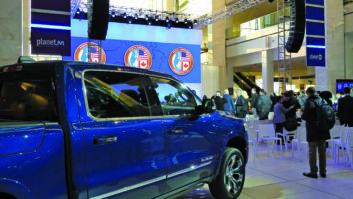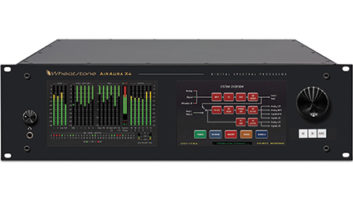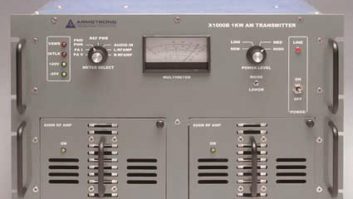Almost every piece of electronic equipment has a protection mechanism designed to open circuit when a fault occurs. These can be circuit breakers or fuses. There are many types and ratings of such devices, each chosen to compliment a specific application.

Fig. 1: Common 3AG/3AB Size Fuse Holders
The purpose of a protection device is to protect the power supply, not the device(s) it feeds. In nearly all cases, the load device fails, causing the protector to open circuit. An internal fuse will protect printed circuit board traces, wiring and other connections from failing due to excessive current drawn by a failed component(s). It will also decrease the chances of fire or additional component failure.
A fuse essentially is a low-resistance wire with a specific melting point. Let’s examine the most popular AC protection devices likely to be encountered by the broadcast engineer who is servicing and troubleshooting the equipment they are intended to protect.
LOW-CURRENT FUSES PROTECTING INDIVIDUAL PIECES OF EQUIPMENT
When a piece of equipment shows no signs of life, we usually suspect a blown fuse.
A common location for a fuse is on the rear panel in close proximity to the power cord. Fig. 1 shows various external panel and internal mount fuse holders. A popular location for an internally mounted fuse is shown in Fig. 2, near the power transformer or in the power supply section. In this equipment, the fuse sockets are mounted directly on the printed circuit board.
The holders shown accommodate the Littelfuse 3AG size. The designation of 3AG was born in 1927, when Littelfuse began manufacturing low amperage fuses. The number 3 was the third size placed on the market. The AG was an abbreviation for the Automotive Glass used in the case construction. The designation AB was used for materials other than glass such as Bakelite, ceramic or fiber. Ceramic is often used where there is concern that glass may shatter during a catastrophic fuse failure. (This info is from the Littelfuse catalog, revised Jan. 12, 2009.)

Fig. 2: Internal printed circuit board fuse placement
One specification for fuses is the ambient temperature of the environment in which the fuse resides. This can be appreciably higher than the room temperature, given the proximity of the fuse to internal heat generating components such as transformers, resistors, voltage regulators and the like. Most equipment such as those that are rack mounted may not be adequately ventilated, further increasing the ambient temperature. Poor contact in the fuse holder can cause loss and increased heating. The ambient temperature at which fuses are specified and tested is 25 degrees C or 77 degrees F.
Fuses are, by nature, temperature-sensitive. Minor temperature variations in which fuses are evaluated can have significant impact on their predicted life when they are subjected to 100 percent of rated values. The fuse temperature will vary with the current passing through it as the ambient temperature changes. It is recommended that fuses be operated at 75 percent of the nominal current established during the evaluation process. A 2-amp fuse should have no more than 1.5 amps flowing through it under normal operating conditions. Slo-Blo fuse designs employ lower temperature melting materials in their construction and are more sensitive to temperature variations.
OHM’S LAW REVISITED
Fuse operation is based on Ohm’s Law. The total current in a series circuit flows through each element. A fuse is placed in series with a load and will open if the current flowing through it exceeds its rating in a specified time. Load currents can vary and are not always static.
An example would be the significant inrush current required to start a motor or charge a filter capacitor after a rectifier. The momentary demand is greater than the quiescent current requirement of the equipment to which it is attached. The designer must consider how best to protect the equipment and minimize nuisance fuse failures. This is why fuses have different failure characteristics given the same current rating.
Some fuses are very fast-acting. A typical application for fast-acting “rectifier” fuses is in a MOSFET RF amplifier used in an AM PDM-based transmitter. The purpose of the fuse is to protect the PC board traces and thin coupling transformer windings (if used), which can burn under excessive current. The fuse will fail after the MOSFET has shorted; it will not prevent the MOSFET from failing. In this case, replacing a GBB type very-fast acting fuse with a 3AB type of the same current rating can have catastrophic consequences. It would be an issue of timing, that is, the same excessive current flowing through critical components for a longer amount of time.
One can consider all components before a fuse to “be” a fuse. For example, if a piece of gear produced a dead short, the power cord, receptacle, AC wiring and circuit breaker all may fall victim to burning possibly causing a fire.
TYPES OF FUSES
Fuses to protect equipment are manufactured in many forms. Fig. 3 is an image of the popular Littelfuse 3AG fast-acting fuse. Fig. 4 shows two variations of the Littelfuse Type 313 Slo-Blo Fuses. Notice the internal 22 ohm, 1/4 watt resistor in the 1/8 amp fuse shown on the left. Shown on the right is coiled construction employed in a 1.25 amp fuse. Ceramic material in Fig. 5 is used to prevent glass rupture in failure mode in the Littelfuse Type 314 Ceramic Body Slo-Blo type.



Fig. 3: Littelfuse Type 312 fast-acting fuses. Courtesy LittelfuseFig. 4: Littelfuse Type 313 Slo-Blo fusesFig. 5: Littelfuse Type 314 ceramic body Slo-Blo fuse. Courtesy Littelfuse
Interestingly, not all fuses look like fuses. For protection in surface-mount PC boards, the Littelfuse Type 437 (Fig. 6) can be employed and is similar in appearance to other components. Littelfuse compact footprint type 874 fast-acting fuse (Fig. 7) occupies less surface area where physical space is at a premium. The 874 does not use external end caps for interface but has single pigtail leads to achieve a higher current rating. The Pico II very fast-acting Type 251 subminiature fuse (Fig. 8) has an appearance similar to a metal film resistor. These are mostly used in LCD-based monitors, office machines and audio/video gear.



Fig. 6: Littelfuse Type 437 surface-mount Fuse. Courtesy LittelfuseFig. 7: Littelfuse Type 874 single-pigtail 3.6 x 10 mm fuse. Courtesy LittelfuseFig. 8: Littelfuse Type 251 Pico II very-fast-acting fuse. Courtesy Littelfuse
Each fuse type not only has a different current rating, but also a nominal melting energy. This is the energy required to melt the fusing element and is expressed as Ampere squared seconds (A2sec). A fuse with a given current rating does not open precisely at that specification. In other words, a fuse with a 2-amp rating does not open at 2.000 amps while remaining intact at 1.999 amps. Each fuse type is rated to withstand a specified amount of current for a given period of time. The datasheet for the specific fuse should be consulted for this information. Slo-Blo fuses incorporate a thermal delay design, allowing them to survive startup pulses while providing protection against prolonged overloads while having a greater sensitivity to ambient temperature.
Fuse evaluation data is gathered using standards established by various organizations. The voltage rating for a given fuse is the maximum at which the device can be safely operated.
CIRCUIT BREAKERS
Another protection mechanism is a circuit breaker.
Like a fuse, these are placed in series with a load and will open circuit when an amount of current exceeding its rating is encountered. Unlike most fuses, circuit breakers can be reset after the fault is corrected.
Littelfuse offers the Poly-Fuse, a polymeric positive temperature coefficient fuse that increases resistance with increased current, thus acting as protection. The device will automatically reset to its low-resistance state once the device is turned off and the overload corrected.



Fig. 9: Eaton 20 Amp circuit breaker. Courtesy EatonFig. 10: Eaton 50 Amp common trip single-phase circuit breaker. Courtesy EatonFig. 11: Eaton 100 Amp common trip three-phase circuit breaker. Courtesy Eaton
Conventional circuit breakers are typically reset by pushing a button or moving a handle. Like fuses, circuit breakers are offered with different current ratings and operating characteristics.
The most common location to find a circuit breaker is in the AC switch panel, which is fed from the power company electric meter. A main circuit breaker is typically a common-trip, single-phase or three-phase model and individual branch circuit breakers are used for standard 120 VAC distribution.
Fig. 9 shows a 20-amp branch circuit breaker. Fig. 10 shows a common-trip single-phase circuit breaker with a 50-amp rating. A fault in either or both branches will trip the device. Fig. 11 is a common-trip 100-amp three-phase model. This can serve as a main circuit breaker or branch breaker feeding a device with a high AC power requirement.

Fig. 12: AC power strip with circuit breaker and MOV protection. © CableWholesale.com Another common application of a circuit breaker is one that is embedded in a power strip. Excessive current drawn by any outlet(s) will open the circuit breaker thus protecting the path to the switchboard panel. Such a power strip is shown in Fig. 12.
AC power circuit breakers, like fuses, can have different operating specifications given the same current rating. They can be fast- or slow-acting depending on application.
Other types of circuit breakers include GFI (Ground Fault Interruption), which are generally used in power feeds to hot tubs and pools, and arc suppression breakers, designed to open circuit under a sustained arc condition.
SHORT CIRCUIT PROTECTION
We’ve been discussing protection devices that are designed to open a current path. Another form of protection is a device that is intended to short circuit under spike or excessive voltage. This family of devices includes the popular MOV (Metal Oxide Varistor). The power strip shown in Fig. 12 uses MOVs and internal circuit breakers for protection. MOVs can be placed from a hot leg to ground and neutral and from neutral to ground. Other devices that employ this technology include TVSS (Transient Voltage Surge Suppressor), which are installed at the main entrance switch panel.
In closing: The purpose of this discussion is to educate the reader on the various forms of AC power protection found in a typical broadcast facility. Note that there are varieties of device designed specifically for other applications such as telephone, ballast and non-broadcast uses. The equipment designer employed a specific type of fuse; its replacement should be the exact same type and rating.
Tom Osenkowsky is an engineering consultant based in Brookfield, Conn. He is a Senior Member of IEEE, iNARTE and SBE and has designed, constructed and maintained radio stations in the U.S. and Caribbean Islands.





